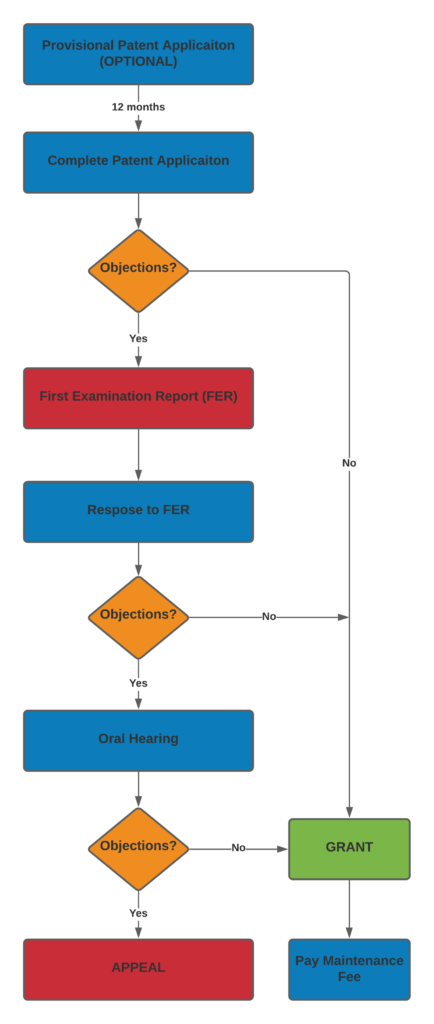
Patent Filing Procedure in India
Once you’ve decided to go for patent registration, the next step is to prepare the patent specification. Patent applications can be filed in India by a registered patent attorney. A Patent Attorney who is well versed with the patent filing procedure in India will help you prepare a written specification, drawings, and the necessary forms for filing your patent application in the Indian Patent Office. The attorney will help you prepare the application according to the provisions laid down in The Indian Patent Act, 1970 and The Patent Rules, 2003. Make sure that you share every piece of information related to your invention with your Patent Attorney since it is pertinent to include details regarding the working of your invention in the patent application.
Types of Patent Applications
The documents required for patent registration may vary depending on the type of patent application you are applying for. The application could be a:
- Provisional Application
- Complete Application (Ordinary – Direct Application)
- Complete Application (Ordinary – After Provisional)
- Convention Application
- PCT International Application
- PCT National Phase Application
- Divisional Application
- Patent of Addition
Read the article provided in this link to get a detailed overview of the different types of patent applications.
Do not be concerned about the abovementioned list if you are new to patents. Most probably, you’d be going for Option 1 (Provisional Application) or Option 2 (Complete Application). Now, let’s understand the procedure involved in filing patent applications in India.
Filing procedure for a provisional patent application in India
The documents required for filing a provisional patent in India include:
- Form 1 (Application for grant of a Patent) – This document includes details of the inventors, declarations, signatures, etc.
- Form 2 – Written specification & drawings (if drawings are mentioned in the specification).
- Form 26 – Form for authorization of a Patent Agent/or any person in a matter or proceeding to be submitted with a stamp paper of prescribed value (the value of the stamp paper varies with each state).
- Form 28 – If you are a startup or an SME, submit supporting documents.
Once these documents are prepared, they are to be uploaded into the e-filing portal of the Indian Patent Office. The uploaded documents are to be signed digitally by the representing patent attorney/agent before submission and payment of the official fee. The documents can also be filed physically through the physical filing counters located at the patent office.
Filing procedure for complete application in India
The documents required for filing a complete application in India include:
- Form 1 (Application for grant of a Patent) – This document includes details of the inventors, declarations, signatures, etc.
- Form 2 – Written specification & drawings (if drawings are mentioned in the specification).
- Form 3 – Statement of undertaking detailing information regarding foreign filings for the same invention.
- Form 5 – Declaration as to inventorship.
- Form 26 – Form for authorization of a Patent Agent/or any person in a matter or proceeding to be submitted with a stamp paper of prescribed value (the value of the stamp paper varies with each state).
- Form 28 – If you are a startup or an SME, submit supporting documents.
Once these documents are prepared, they are to be uploaded into the e-filing portal of the Indian Patent Office. A patent agent/attorney representing you will digitally sign the documents before submission and payment of the official fee. The documents can also be filed physically through the physical filing counters located at the patent office.
Drafting the Patent Application
Form 2 which includes the written specification and drawings forms the vital part of the application. The written specification includes details such as the title of the invention, the background of the invention, the summary of the invention, the brief description of the drawings, the detailed description, and most importantly the claims of the invention. The process of preparing the written specification and associated drawings is referred to as patent drafting. Read the article titled “Patent Specification – Laws in India” authored by the Consulting Counsel of Acura IP Services, Adv. Sutapa Jana to know more about the intricacies of patent specifications.
The process of patent drafting includes preparing the written specification and drawings according to the provisions laid down by the Indian Patent Act, 1970 and The Patent Rules, 2003. As a result, patent drafts are widely considered techno-legal documents, the drafting of which requires the artisan to have skills in the field of science, technology, and law.
A successful patent provides a legal monopoly over the invention to an individual or organization for a period of 20 years. Hence, the patent office thoroughly examines and scrutinizes each application for its novelty, inventive step, and industrial applicability. It is highly recommended to go with an experienced patent attorney for drafting your patent application unless you are a serial inventor with prior experience handling multiple patent applications.
After Filing – Patent Pending to Patent Grant
Upon successful filing and fee payment, you will receive an application number. Once you’ve applied for a patent, you can legally use the “patent pending” tag with your product. The patent-pending tag comes with multiple advantages including:
- Warning potential infringers (including competitors) about impending legal action.
- Potential to increase sales – Customers appreciate novel products and a patent-pending tag helps them appreciate the novelty of your product.
- Potential to increase investment prospects – The investing community keeps a close eye on organizations that constantly pursue patent protection. The pursuit of obtaining more patents signals that the business is innovative and valuable. IP Valuation is one of the core parameters considered by investors when valuing a business.
- Licensing rights – You can license your patents even during the application (pending) stage.
- Priority date – When you file your patent application, you get a filing date and application number in India. You can use this application as a reference to extend your patent protection to other jurisdictions.
Once you file your complete application, the patent office will conduct a prior-art search of their own and examine your application for novelty and inventive step. You can monitor the status of your application by searching for your application in the patent database maintained by the Indian Patent Office. Post examination, you will most likely receive a First Examination Report (FER) from the patent office. This document lists out the deficiencies (if any) identified by the patent office with respect to your patent application. You must prepare and submit a response to the same to the patent office within the prescribed time to overcome the objections. In some cases, the patent office may arrange an oral hearing for discussing the objections for deciding the fate of the patent application.

The whole process might seem lengthy and complicated at first glance. The experience and expertise of a patent lawyer, on the other hand, can help you navigate all these hurdles with confidence. Are you ready to take the next step? Contact us right away and get started. Your first consultation is on us.



Interpretation of Section 3(i) of the Indian Patent Act, 1970 in the Context of Non-Invasive Prenatal Testing
Introduction The advent of Non-Invasive Prenatal Testing (NIPT) has revolutionized…

Branded Medicines vs. Generic Medicines: The Role of Patents
In the pharmaceutical industry, the distinction between branded and generic…

Utility Patents vs Design Patents (Industrial Designs)
While the definition of Patent merely covers…
Categories
Recent Discussions
Interpretation of Section 3(i) of the Indian Patent Act, 1970 in the Context of Non-Invasive Prenatal Testing
Introduction The advent of Non-Invasive Prenatal Testing (NIPT) has revolutionized prenatal diagnostics, enabling expectant parents to assess the genetic health of the fetus…
Recent Discussions
Branded Medicines vs. Generic Medicines: The Role of Patents
In the pharmaceutical industry, the distinction between branded and generic medicines is an essential one. Understanding this distinction is crucial not just for…



